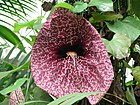Note: This is a project under development. The articles on this wiki are just being initiated and broadly incomplete. You can Help creating new pages.
Aristolochia grandiflora - Duck flower
Aristolochia grandiflora is the pelican flower and it is a deciduous vine with one of the world's largest flowers that emits an odor that smells like rotting meat, attracting flies.
Contents
- 1 Uses
- 2 Parts Used
- 3 Chemical Composition
- 4 Common names
- 5 Properties
- 6 Habit
- 7 Identification
- 8 List of Ayurvedic medicine in which the herb is used
- 9 Where to get the saplings
- 10 Mode of Propagation
- 11 How to plant/cultivate
- 12 Commonly seen growing in areas
- 13 Photo Gallery
- 14 References
- 15 External Links
Uses
Increase sexual desire, Snakebite, Intestinal pain, Gallbladder pain, Arthritis, Gout, Achy joints, Rheumatism, Eczema, Weight loss, Wounds.
Parts Used
Chemical Composition
It includs aristolochic acids and esters, aristolactams, aporphines, protoberberines, isoquinolines, benzylisoquinolines, amides, flavonoids, lignans, biphenyl ethers, coumarins, tetralones, terpenoids, benzenoids, steroids, and others[1]
Common names
| Language | Common name |
|---|---|
| Kannada | Isvaberusa |
| Hindi | Hookbel |
| Malayalam | NA |
| Tamil | Isvaramuli |
| Telugu | Esvaraveru |
| Marathi | NA |
| Gujarathi | NA |
| Punjabi | NA |
| Kashmiri | NA |
| Sanskrit | Gandhanakuli |
| English | NA |
Properties
Reference: Dravya - Substance, Rasa - Taste, Guna - Qualities, Veerya - Potency, Vipaka - Post-digesion effect, Karma - Pharmacological activity, Prabhava - Therepeutics.
Dravya
Rasa
Guna
Veerya
Vipaka
Karma
Prabhava
Habit
Identification
Leaf
| Kind | Shape | Feature |
|---|---|---|
Flower
| Type | Size | Color and composition | Stamen | More information |
|---|---|---|---|---|
| {{{5}}} |
Fruit
| Type | Size | Mass | Appearance | Seeds | More information |
|---|---|---|---|---|---|
Other features
List of Ayurvedic medicine in which the herb is used
Herboline, Kalnaaru Parpam, Meganatha Tailam[3]
Where to get the saplings
Mode of Propagation
How to plant/cultivate
A plant of the lowland tropics, where it is found at elevations up to 600 metres. Prefers a well-drained, humus-rich, loamy soil and a position in full sun or partial shade[4]
Commonly seen growing in areas
Along streams, Secondary-growth thickets, Steam banks.
Photo Gallery
References
External Links
- Pages with reference errors
- Ayurvedic Herbs known to be helpful to treat Increase sexual desire
- Ayurvedic Herbs known to be helpful to treat Snakebite
- Ayurvedic Herbs known to be helpful to treat Intestinal pain
- Ayurvedic Herbs known to be helpful to treat Gallbladder pain
- Ayurvedic Herbs known to be helpful to treat Arthritis
- Ayurvedic Herbs known to be helpful to treat Gout
- Ayurvedic Herbs known to be helpful to treat Achy joints
- Ayurvedic Herbs known to be helpful to treat Rheumatism
- Ayurvedic Herbs known to be helpful to treat Eczema
- Ayurvedic Herbs known to be helpful to treat Weight loss
- Ayurvedic Herbs known to be helpful to treat Wounds
- Herbs with Stem used in medicine
- Herbs with Leaves used in medicine
- Herbs with Roots used in medicine
- Herbs with common name in Kannada
- Herbs with common name in Hindi
- Herbs with common name in Tamil
- Herbs with common name in Telugu
- Herbs with common name in Sanskrit
- Habit - Climber
- Index of Plants which can be propagated by Seeds
- Index of Plants which can be propagated by Softwood cuttings
- Herbs that are commonly seen in the region of Along streams
- Herbs that are commonly seen in the region of Secondary-growth thickets
- Herbs that are commonly seen in the region of Steam banks
- Herbs
- Aristolochiaceae







